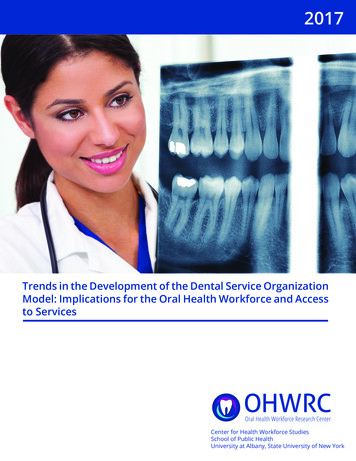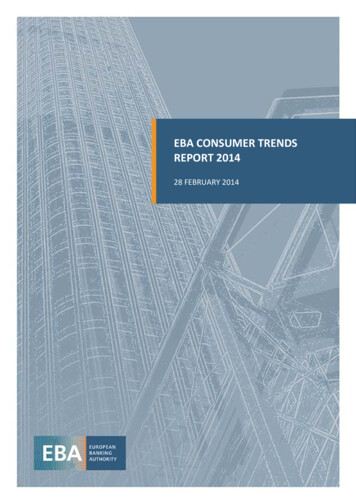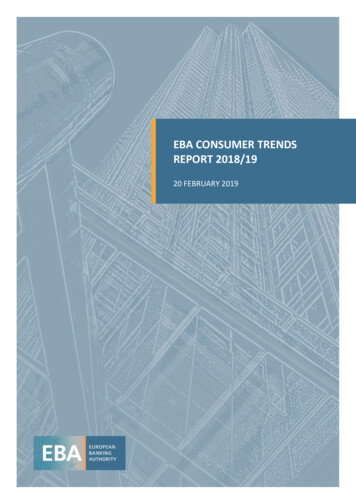
Transcription
2017Trends in the Development of the Dental Service OrganizationModel: Implications for the Oral Health Workforce and Accessto ServicesCenter for Health Workforce StudiesSchool of Public HealthUniversity at Albany, State University of New York
Trends in the Development of the Dental ServiceOrganization Model: Implications for the Oral HealthWorkforce and Access to ServicesAugust 2017Center for Health Workforce StudiesSchool of Public Health, University at AlbanyState University of New York1 University Place, Suite 220Rensselaer, NY 12144-3445Phone: (518) 402-0250Web: www.oralhealthworkforce.orgEmail: info@oralhealthworkforce.org
PREFACEThe Oral Health Workforce Research Center (OHWRC) at the Center for Health Workforce Studies(CHWS) at the University at Albany’s School of Public Health completed a research project usingmixed methods to describe the development of dental support organizations in the US. A surveyof a convenience sample of DSOs was conducted and case studies of 6 dental support organizationsdelivering general or specialty dental services to patients were compiled. The study was conducted inthe spring of 2017.This report was prepared for OHWRC by Margaret Langelier, Shen Wang, and Simona Surdu from CHWSand by Elizabeth Mertz and Cynthia Wides of the Healthforce Center at the University of California, SanFrancisco, with layout design by Leanne Keough. OHWRC is supported by the US Health Resources andServices Administration (HRSA) of the US Department of Health and Human Services (HHS) under grantnumber U81HP27843, a Cooperative Agreement for a Regional Center for Health Workforce Studies. Thecontent and conclusions of this report are those of OHWRC and should not be constructed as the officialposition or policy of HRSA, HHS, or the US government, nor should any endorsements be inferred.The mission of OHWRC is to provide accurate and policy-relevant research on the impact of the oralhealth workforce on oral health outcomes. The research conducted by OHWRC informs strategiesdesigned to increase access to oral health services for vulnerable populations. OHWRC is based at CHWSat the School of Public Health, University at Albany, State University of New York (SUNY), and is the onlyHRSA-sponsored research center with a unique focus on the oral health workforce.The views expressed in this report are those of OHWRC and do not necessarily represent positions orpolicies of the School of Public Health, University at Albany, SUNY, or other subcontractors.August 2017iiOral Health Workforce Research Center
ACKNOWLEDGMENTSSpecial appreciation is extended to the leadership and staff of the Association of Dental SupportOrganizations—especially Bill Head and Stacy Swanson, who helped OHWRC identify studyparticipants—and to the key informants from the 6 organizations that participated in the case studies.Thanks are also extended to the dental support organization executives who responded to the surveyand provided information to describe their organizations, their locations, and their patients.The authors also wish to acknowledge the National Center for Health Workforce Analysis for the fundingthat supported this work.Suggested Citation:Langelier M, Wang S, Surdu S, Mertz E, Wides C. Trends in the Development of the Dental ServiceOrganization Model: Implications for the Oral Health Workforce and Access to Services. Rensselaer, NY: OralHealth Workforce Research Center, Center for Health Workforce Studies, School of Public Health, SUNYAlbany; August 2017.Trends in the Development of the Dental Service Organization Modeliii
TABLE OF CONTENTSEXECUTIVE SUMMARY.1TECHNICAL REPORT.19BACKGROUND.20STUDY DESIGN.24FINDINGS.25Current Literature.25Secondary Data Describing DSOs. 34Primary Data Describing DSOs.40Case Studies of 6 DSOs in the US.61DISCUSSION.77APPENDIX A (Case Studies).79APPENDIX B (Interview Questions).109APPENDIX C (Survey Instrument).115APPENDIX D (Narrative Responses to the Survey).125REFERENCES.129ivOral Health Workforce Research Center
TABLES AND FIGURESTable 1. Categorial Types of Large Group Dental Practices.26Table 2. Offices of Dentists by Number of Employees in Firms and the Establishmentof Firms in the US: 2002, 2007, and 2012.35Table 3. Offices of Dentists (Firms) by Number of Establishments per Firm in the US:2002, 2007, and 2012.35Figure 1. Number of Establishments Operated by the Largest Firms (Offices ofDentists) in the US: 1992, 1997, 2002, 2007, and 2012.36Table 4. Respondent Organizations’ Designations of Type of Organization (N 32).44Figure 2. Number of DSO Survey Respondents With Affiliate Practices by State.46Figure 3. Services Provided to Dental Office Affiliates by the DSOs (N 31).47Table 5. Descriptive Statistics of Number of Patients Serviced in DSOs in 2016.47Table 6. Types of DSO Affiliations With Dentists Within the Organization (N 30).49Figure 4. Number of Full-time Dentists by Number of DSOs (N 29).49Table 7. Number of Full-time (FT) and Part-time (PT) Dentists in the DSOs.50Table 8. Percentage of DSOs Responding to the Survey Question by the Percentageof General, Pediatric, and Specialty Dentists on Their Clinical Staff.51Table 9. Percentage of New Dentist Recruits Who Are New Dental SchoolGraduates, New Graduates of Dental Residency Program, or Experienced Dentistsby the Percentage of DSO Survey Respondents.52Table 10. Range of the Ratios of Dental Hygienists (DHs) to Dentists and DentalAssistants (DAs) to Dentists in DSO Affiliate Practices.54Table 11. Range in the Number of Full-time (FT) and Part-time (PT) DentalHygienists (DHs) by Percentage of DSOs.54Table 12. Range in the Number of Full-time (FT) and Part-time (PT) DentalAssistants (DAs) by Percentage of DSOs.55Table 13. Percentage of DSO-Affiliated Dentists Serving Some Patients Insured byMedicaid or CHIP by Percentage of DSO Respondents.56Trends in the Development of the Dental Service Organization Modelv
Table 14. Percentage of the Total Patient Population That Is Publicly Insured by thePercentage of DSO Survey Respondents.57Table 15. Percentage of the Total Medicaid- or CHIP-Insured Patient Population ThatAre Children by the Percentage of DSO Survey Respondents.58Figure 5. Number of Survey Respondents With Affiliated Practices Serving PubliclyInsured Patients by State.59viOral Health Workforce Research Center
Executive Summary
BACKGROUNDDental services in the US are traditionally provided in private dental practices operating as smallbusinesses. These practices generally consist of one or two dentists employing dental hygienists, dentalassistants, and administrative support staff. While this continues to be the mode of delivery of dentalservices at present, organizational structures for oral health service delivery and for managing businessfunctions are changing, resulting in a variety of options for patients seeking dental services from dentalprovider organizations. Perhaps the most noticeable change in the dental practice paradigm is theconsolidation of small private dental practices into large groups.Group dental practices are variously organized under assorted business models and structural labels.The term “group practice” encompasses different organizational configurations, including large general orspecialty dental practices under dentists’ ownership, consolidated practices owned by corporate businessentities, consortia of small private dental practices in contract with dental support or service organizationsor under partial or total ownership of dental management organizations, staff model health/dentalmaintenance organizations, dental accountable care organizations, and so on. These entities may bepublicly or privately held, for-profit or not-for-profit, and organized under a variety of legal arrangementsincluding professional partnerships and publicly held corporations.Dental support organizations (DSOs) provide practice management services such as employment andhuman resources, billing, accounting, regulatory compliance, lease arrangements, purchasing services,and information infrastructure and technical tools for clinical decision-making. DSO-affiliated dentistsand practices often share clinical information systems to aid in evaluating progress toward meaningfuluse objectives and monitoring of clinical outcomes in the patient population. The configurations of DSOsvary widely, with some consisting only of DSO-employed dentists and others comprising small privatepractices that retain individual ownership and contract with a DSO for nonclinical administrative services.Recently, the number of DSOs has grown substantially across the US, driven in part by the Affordable CareAct, which increased enrollment in state Medicaid programs, especially among adults. Medicaid dentalbenefits vary by state. Although all children in the US who qualify for a health insurance benefit throughMedicaid or the Children’s Health Insurance Program (CHIP) also have a dental benefit, in many states,qualifying adults have no coverage for dental services within the Medicaid program or dental coverage islimited to emergency care. Because of this state-by-state variation in coverage, a DSO may provideservices for patients with Medicaid in one state while the same DSO may not treat Medicaid-eligiblepeople in another state where there is either no or a very limited adult dental benefit.2Oral Health Workforce Research Center
Concerns around those who do not regularly receive dental services due to social, economic, andgeographic disparities are pervasive. The market for dental services to low- and low-middle–incomepeople, especially adults, is largely untapped. These populations are underserved for health and dentalservices, presenting a market opportunity for dental providers. As state Medicaid programs increasinglyshift patients to managed care plans, some DSOs have leveraged their business model to serve moreMedicaid patients.DSOs with sufficient and efficient scale and with the agility to contain costs are able to enter these marketsand increase the availability of and access to oral health services. As a result of the economies accruingto practice consolidations, DSOs appear to be more apt and perhaps more able to accommodate lowerreimbursement from public insurance programs than smaller private dental practices, partly due to theirability to treat patients at lower individual cost and reduced overhead.Dental health maintenance and dental accountable care organizations that participate with stateMedicaid programs are often capitated for patient care through a per-member, per-month paymentsystem. This reimbursement incentivizes value-based care focusing on prevention and early interventionin oral disease processes to preclude less costly treatment services. These payment models also supportthe importance of establishing a dental home where preventive oral health services are provided.DSOs now account for a growing share of provider organizations. The impact of DSOs on increased accessto services for underserved populations has been noted, but their actual contributions to care for thesepopulations is only sparsely documented.Trends in the Development of the Dental Service Organization Model3
STUDY DESIGNTrends in consolidation of dental practices and the business, organizational, and workforce models thatenable these large practices have not been well researched. One objective of this study was to identify andanalyze data describing these organizations; another was to conduct interviews with DSOs to understandthe qualitative aspects and benefits of management alliances. This mixed-methods study was exploratoryin nature.This report examines the available literature on DSOs, focusing on the patients served, workforcerecruitment and retention strategies, new and established dentists’ career pathways, and evolving modelsof DSOs’ service deployment. In addition, it presents secondary data from national data sources todescribe growth in large group dental practices in the US and primary data from an online survey ofa convenience sample of 47 DSOs in the US. These data describe the services provided by respondents,the states in which the DSOs are located, and the patients served by the organizations. Finally, thereport describes qualitative case studies of 6 DSOs to understand their organizational models,recruitment and retention practices for the dental workforce, and impact on access to services forunderserved populations.4Oral Health Workforce Research Center
FINDINGSSecondary Data Describing DSOsThe Economic Census of the US Census Bureau provides some important information about changes inthe configuration of dental practices over the decade beginning in 2002 and ending in 2012. This survey ofbusiness firms occurs every 5 years, and the data are reported by North American Industry ClassificationSystem (NAICS) codes. The Health Care and Social Assistance Sector of the NAICS (Sector 62) includes theoffices of dentists (NAIC Codes 6212, 62121, 621210). The census collects information on severalcharacteristics of businesses, including the number of employees by type, specialty of practice, annualrevenues, number of individual establishments operated by the firm, and annual payroll. Because of theconsistent data elements in the survey over time, it is possible to track the size of dental practices overthe 10-year period.In the period between 2002 and 2012, the number of firms (offices of dentists) with 50 to more than 1,000employees increased from 284 to 438. The number of establishments (locations) operated by larger firmsincreased from 2,691 in 2002 to 5,485 in 2012. While the number of very large firms remains small, therewas growth in the number of establishments/sites at which these firms operate. In 2002, 3 firms operatedwith more than 1,000 employees in 788 establishments. By 2012, 11 firms reported more than 1,000employees working in 3,005 establishments.A similar magnitude of growth was observed in the number of firms (offices of dentists) reporting 10 ormore establishments/sites for providing dental services. In 2002, 41 firms reported operations in morethan 10 establishments, totaling 2,131 locations in the US. In 2012, 67 firms reported operations in morethan 10 establishments, totaling 4,480 locations, an increase of 110% in the number of establishmentsreported by firms in this category.Primary Data Describing DSOsThe Survey of DSOsIn the spring and early summer of 2017, the OHWRC conducted a short survey of a convenience sampleof 47 DSOs in the US. The online survey included questions about the structure and location of DSOs andthe patients served by affiliates. The survey contained 15 questions and used a skip-logic design toencourage survey completion. This method prompts a “yes” respondent to an elaborating question whilea “no” respondent moves to a subsequent question. The survey took between 10 and 15 minutes tocomplete. Some questions had predefined response options, while others were open-ended to allowTrends in the Development of the Dental Service Organization Model5
for a narrative response. The survey instrument is included in Appendix C of the technical report.Narrative responses to the survey are included in Appendix D.The Web-based survey was mounted on the Qualtrics platform; responses were directed to and residedon a dedicated server at the OHWRC at CHWS. This project was reviewed by the New York StateDepartment of Health Institutional Review Board (IRB) (Study #1035761-1).Potential respondents were members of the Association of Dental Support Organizations (ADSO).Executive staff at ADSO sent a personalized email to their US members in May 2017 requestingparticipation in the online survey. The email explained the purposes of the research and theconfidentiality of responses, and provided respondents with contact information for study personnel atthe OHWRC as well as for IRB staff.Two reminder emails were sent to nonrespondents at 2-week intervals. Reminder emails were sent onlywhen there had been no response from the organization. The survey closed to accruals on Monday, June19, 2017. The number of responding organizations was 32 of the 47 solicited to participate; the responserate was 68.1%.Due to the limitations of the sample design and the inability to determine representativeness of theresponding organizations, these results may not be broadly generalizable. However, they are ofinterest especially because they explain the diversity of DSOs in the US. The detailed frequencies andcross-tabulations that provide a summary description of the DSOs responding to the survey can be foundin the technical report of project activities.Findings from the survey included the following: DSOs defined their organizations in various ways, suggesting functional differences among similar organizations within the broad class known as “dental support organizations” (87.5%).Many additionally defined themselves as a “dental service organization” (46.8%), a “dentalmanagement organization” (34.4%), or a “dental management service organization” (28.1%). DSOs were mainly for-profit organizations (96.8%), and a majority were privately held (62.5%). DSOs were operating in 48 states and in the District of Columbia. There was no DSO presenceamong respondent groups in Alaska and Montana. All DSOs (100.0%) provided similar business and management services. However, fewer than 6Oral Health Workforce Research Center
three-quarters (71.9%) had a common electronic dental record, and fewer than half (46.9%)provided clinical care protocols to affiliates. DSOs varied in the number of patients served by practice affiliates in 2016. The range was6,000 to 1,600,000 patients. The number of patients served by a DSO was not necessarily an indicator of the number ofstates in which that DSO operated. Some DSOs with large numbers of patients operated inonly one state, while other DSOs with smaller numbers of patients operated in multiple states. Dentists affiliated with DSOs in various ways, including as associates (66.7%), owners (66.7%),and employees (53.7%). The mean number of full-time (FT) dentists affiliated with a DSO was 213; the number of FTdentists in DSOs ranged from a minimum of 6 to a maximum of 1500. The median number ofFT dentists was 60. Eighteen (56.3%) of the 32 DSOs indicated that they had some part-time (PT) dentists. Themean number of PT dentists in those DSOs was 36. The median number was 28, and the modewas 100; the range was from 3 to 100 PT dentists. DSOs’ affiliate practices were mainly staffed by general dentists. Approximately 90% of surveyrespondents indicated that between 61% and 100% of dentists in the organization weregeneral dentists. DSOs indicated that they experienced more-than-average difficulty (mean of 3.6 on a 5-pointscale) recruiting dentists to their organizations. However, DSOs also indicated below-averagedifficulty (mean of 2.67 on a 5-point scale) retaining dentists once hired to the organization. DSOs recruited some new dental school graduates annually, but the main source of newrecruits to many of the organizations was experienced dentists. Sixty percent of surveyrespondents indicated that between 51% and 100% of new recruits annually wereexperienced dentists. DSOs observed that dentists are attracted to work with a DSO by the salary/compensationpackages, by the location of DSO practices, and by the career opportunities afforded withinthe organization.Trends in the Development of the Dental Service Organization Model7
While DSO affiliate practice staff included dental hygienists (DHs) and dental assistants (DAs), the use of auxiliaries varied substantially across organizations. Most DSOs had between 1 and2 DAs, on average, per dentist. Most had less than 1 DH per dentist on average. The number of FT and PT DHs varied widely among DSOs. The range in number of FT DHs was 0 to 800. The range in number of PT DHs was 0 to 100. The number of FT and PT DAs also varied widely among DSOs. The range in number of FT DAs was 0 to 2,900. The range in number of PT DAs was 0 to 200. Thirty of the DSOs that participated in the survey research responded to a question asking if any of the dentists affiliated with the organization treated patients insured by Medicaid orCHIP. Eighty percent indicated that at least some dentists affiliated with the DSO treatedpublicly insured people. Sixty-one percent of DSOs that served Medicaid-insured patients indicated that 50% or more of the dentists affiliated with the organization treated some patients insured by Medicaid orCHIP, with 43.5% of DSOs indicating that between 91% and 100% of affiliated dentists servedsome patients who were publicly insured. Twenty-two DSOs answered a question about the percentage of the patient population that was Medicaid or CHIP insured. More than one-third of these DSOs (36.4%) indicated that 50%to 95% of the patient population served by the organization was publicly insured. Most of the Medicaid or CHIP population served by DSO affiliate practices were children. Nearly two-thirds (63.6%) of respondents indicated that more than 60% of the Medicaidinsured population served in affiliate practices were children. Twenty-three of the 32 survey respondents (71.9%) indicated that they served Medicaid- or CHIP-insured patients in at least one state in which they had dental practice affiliates.Summary of Survey FindingsThis survey of DSOs was conducted to further the literature describing business support organizations inthe dental service delivery market in the US. The accumulated data describe a diverse group ofmanagement organizations that provide a common core of business and information services butotherwise vary substantially in size and focus. DSOs appear to be diverse in locations of practice, in typesof offered services, and in patients served.8Oral Health Workforce Research Center
The DSOs that responded to this survey described a focus on management services with only limitedinvolvement in any aspect of clinical dentistry. Some DSO affiliates focused on specialty services, whilemost provided general dentistry services or a mixture of general and specialty care. Some DSOs werelocated in only a single state while others showed significant penetration in multiple states.DSO were actively recruiting workforce, including dentists, DHs, and DAs. DSOs appeared to have somedifficulty in recruiting dentists to their organization. This may be due to an increasing variety of optionsavailable to dentists—for example, private practice, working in a DSO, the military and public healthservice, and employment with not-for-profit provider organizations such as federally qualifiedhealth centers.DSOs affiliated with dentists through a variety of mechanisms, including direct employment, associationwith a professional corporation or practice association, and even contractual arrangements. Oneinteresting finding was that most dentists recruited to DSOs each year were experienced dentists. Thisfinding is likely coincidental to DSOs’ strategy of affiliating with private-practice dentists who already haveestablished practices.As anticipated, DSOs were largely supported by investments of private equity, but none of the respondentorganizations was a publicly held corporation. The involvement of private equity was an expected findingbecause the scale of management services offered by these organizations would generally requiresubstantial capital investment beyond the capability of many individual dentists. However, it is notcurrently possible to anticipate further moves to public holding, as DSOs are gaining in size and mayeventually evolve to public entities.One of the most important findings from this survey is that DSOs are serving Medicaid- and CHIP-eligiblepatients to an appreciable degree. Reimbursement from public dental benefits is below usual andcustomary fees, making it difficult for small-scale providers to absorb costs related to dental serviceprovision to the publicly insured. DSOs leverage size and market penetration to the advantage ofboth their organizational affiliates and the public, making dental services more affordable andreadily accessible.While the survey data are mainly descriptive, they are helpful in understanding the wide variation withinthe classification of DSOs. Further research is needed to better understand the universe of DSOs inthe US.Trends in the Development of the Dental Service Organization Model9
Case Studies of 6 DSOs in the USIn April and May of 2017, project staff conducted telephone interviews with key personnel at 6 DSOs inthe US. These organizations generally fell within the American Dental Association’s classification of “dentalmanagement organization affiliated group practices.” The more commonly used “DSO” is the collectiveterm employed throughout this report to describe these large group dental practices under commonbusiness management.Although guided by a protocol of questions, the interviews for these case studies were largelyunstructured to allow informants to provide general information about the composition and structure oftheir organizations and the patients served. Representatives of the 6 DSOs that provided interviewsself-selected to participate in the case studies after hearing about the project during a presentation byproject staff to the Medicaid Compliance Committee at the annual meeting of ADSO in March 2017. Mostof the DSOs in the case studies were serving patients insured by Medicaid in the states in which theseDSOs operated—hence the presence of their executive staff at the Medicaid compliance meeting. Thetargeting of Medicaid-predominant DSOs for the interviews was purposeful and was among the criteriain the original proposal for this project. Descriptive summaries of each of these DSOs may be found inAppendix A of the technical report for this study. The interview protocol may be found in Appendix B.The 6 DSOs participating in the case study interviews were: Affordable Care LLC headquartered in Raleigh and Kinston, North Carolina Benevis headquartered in Marietta, Georgia Community Dental Partners headquartered in Denton, Texas Dental Care Alliance headquartered in Sarasota, Florida Perfect Dental Management headquartered in Needham, Massachusetts STX Healthcare Management Services, Inc. headquartered in Bellaire, TexasThe purpose of the case studies was to identify common themes and differences among a selection ofDSOs in the US. Although the DSOs in the case studies had differing target populations and catchmentareas, there were common characteristics and objectives, which are summarized under the followingthemes. As the number of interviews was small, these findings may not be broadly generalizable.10Oral Health Workforce Research Center
Common Themes From the InterviewsThe following common themes emerged from the interviews. Economic and regulatory influences, including costs associated with delivering oralhealth services, drive the growth in the number of DSOs across the US and theirorganizational structures.The current focus in the policy environment and among provider communities and patients on theever-increasing costs of health and oral health services and on their disproportionate distribution andavailability is forcing change in the structure of dental practices. Informants to the case studies were clearthat the small business model in which dentists have historically operated is less able to performoptimally in the current business and regulatory environments than in the pas
services, presenting a market opportunity for dental providers. As state Medicaid programs increasingly shift patients to managed care plans, some DSOs have leveraged their business model to serve more Medicaid patients. DSOs with su ffi cient and effi cient scale and with the agility to contain costs are able to enter these markets











